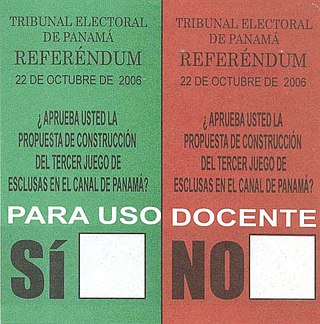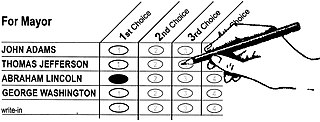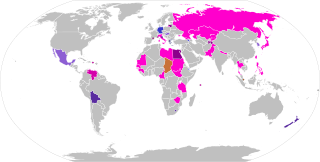Plurality voting refers to electoral systems in which the candidate in an electoral district who poll more than any other are elected.

Proportional representation (PR) refers to any type of electoral system under which subgroups of an electorate are reflected proportionately in the elected body. The concept applies mainly to political divisions among voters. The essence of such systems is that all votes cast – or almost all votes cast – contribute to the result and are effectively used to help elect someone – not just a bare plurality or (exclusively) the majority – and that the system produces mixed, balanced representation reflecting how votes are cast.

The single transferable vote (STV), sometimes known as proportional ranked choice voting (P-RCV), is a multi-winner electoral system in which each voter casts a single vote in the form of a ranked-choice ballot. Voters have the option to rank candidates, and their vote may be transferred according to alternate preferences if their preferred candidate is eliminated or elected with surplus votes, so that their vote is used to elect someone they prefer over others in the running. STV aims to approach proportional representation based on votes cast in the district where it is used, so that each vote is worth about the same as another.
Single non-transferable vote or SNTV is an electoral system used to elect multiple winners. It is a generalization of first-past-the-post, applied to multi-member districts with each voter casting just one vote. Unlike FPTP, which is a single-winner system, in SNTV multiple winners are elected, typically in electoral districts; additionally, unlike FPTP, SNTV produces mixed representation and makes it unlikely for a single party to take all the seats in a city or a set area, which can happen under FPTP.

Voting is a method by which a group, such as a meeting or an electorate, convenes together for the purpose of making a collective decision or expressing an opinion usually following discussions, debates or election campaigns. Democracies elect holders of high office by voting. Residents of a jurisdiction represented by an elected official are called "constituents", and the constituents who choose to cast a ballot for their chosen candidate are called "voters." There are different systems for collecting votes, but while many of the systems used in decision-making can also be used as electoral systems, any which cater to proportional representation can only be used in elections.

First-past-the-post voting is a plurality voting system wherein voters cast a vote for a single candidate, and the candidate with the most votes wins the election. Analogous systems for multi-winner contests are known as plurality block voting or "block voting" systems; both FPTP and block voting are "plurality" systems in that the winner needs only a plurality of the votes and not an absolute majority. The term first-past-the-post is a metaphor from horse racing of the plurality-voted candidate winning such a race; the electoral system is formally called single-member [district] plurality voting (SMP/SMDP) when used in single-member districts, and informally called choose-one voting in contrast to ranked voting or score voting.
An electoral district, also known as an election district, legislative district, voting district, constituency, riding, ward, division, electorate, or (election) precinct, is a subdivision of a larger state created to provide its population with representation in the larger state's constituency. That body, or the state's constitution or a body established for that purpose, determines each district's boundaries and whether each will be represented by a single member or multiple members. Generally, only voters (constituents) who reside within the district are permitted to vote in an election held there. District representatives may be elected by a first-past-the-post system, a proportional representative system, or another voting method. They may be selected by a direct election under universal suffrage, an indirect election, or another form of suffrage.
Limited voting is a voting system in which electors have fewer votes than there are positions available. The positions are awarded to the candidates who receive the most votes. In the special case in which the voter may vote for only one candidate and there are two or more posts, this system is called the single non-transferable vote or sometimes the strictly limited vote.

Bullet, single-shot, or plump voting is when a voter supports only a single candidate, typically to show strong support for a single favorite.
The general ticket, also known as party block voting (PBV) or ticket voting, is a type of block voting in which voters opt for a party, or a team's set list of candidates, and the highest-polling party/team becomes the winner. Unless specifically altered, this electoral system results in the victorious political party receiving 100% of the seats. Rarely used today, the general ticket is usually applied in more than one multi-member district, which theoretically allows regionally strong minority parties to win some seats, but the strongest party nationally still typically wins with a landslide.
The multiple non-transferable vote (MNTV) is a group of voting system, in which voters elect several representatives at once, with each voter having more than one vote. MNTV uses multi-member electoral districts or only one district, which contains all voters, which is used to provide at-large representation.
Preferential block voting is a majoritarian voting system for electing several representatives from a multimember constituency, such as a state. Unlike single transferable voting (STV) or list PR, preferential block voting is not a method for obtaining proportional representation, and instead produces similar results to plurality block voting. Preferential block voting can be seen as a multiple-winner version of instant-runoff, a multiple transferable vote (MTV).
Plurality block voting, also known as plurality-at-large voting, bloc vote or block voting (BV) is a non-proportional voting system for electing representatives in multi-winner elections. Each voter may cast as many votes as the number of seats to be filled. The usual result when the candidates divide into parties is that the most popular party in the district sees its full slate of candidates elected in a seemingly landslide victory.
Semi-proportional representation characterizes multi-winner electoral systems which allow representation of minorities, but are not intended to reflect the strength of the competing political forces in close proportion to the votes they receive. Semi-proportional voting systems can be regarded as compromises between forms of proportional representation such as party-list PR, and plurality/majoritarian systems such as first-past-the-post voting. Examples of semi-proportional systems include the single non-transferable vote, limited voting, and parallel voting.

An electoral system or voting system is a set of rules that determine how elections and referendums are conducted and how their results are determined. Electoral systems are used in politics to elect governments, while non-political elections may take place in business, non-profit organisations and informal organisations. These rules govern all aspects of the voting process: when elections occur, who is allowed to vote, who can stand as a candidate, how ballots are marked and cast, how the ballots are counted, how votes translate into the election outcome, limits on campaign spending, and other factors that can affect the result. Political electoral systems are defined by constitutions and electoral laws, are typically conducted by election commissions, and can use multiple types of elections for different offices.
A majoritarian electoral system is an electoral system where the candidates or parties with the most votes takes all seats using the winner-takes-all principle and in this way provides majoritarian representation. However, there are many electoral systems considered majoritarian based on different definitions, including types of at-large majoritarian representation such as block voting or party block voting, but district-based majoritarian systems such as first-past-the-post voting (FPTP/SMP). Where two candidates are in the running, the one with the most votes will have a majority, but where there are three or more candidates, it often happens that no candidate takes a majority of the votes.

A mixed electoral system or mixed-member electoral system combines methods of majoritarian and proportional representation (PR). The majoritarian component is usually first-past-the-post voting (FPTP/SMP), whereas the proportional component is most often based on party-list PR. The results of the combination may be mixed-member proportional (MMP), where the overall results of the elections are proportional, or mixed-member majoritarian, in which case the overall results are semi-proportional, retaining disproportionalities from the majoritarian component.
Multiwinner approval voting, also called approval-based committee (ABC) voting, is a multi-winner electoral system that uses approval ballots. Each voter may select ("approve") any number of candidates, and multiple candidates are elected. The number of elected candidates is usually fixed in advance. For example, it can be the number of seats in a country's parliament, or the required number of members in a committee.
The mixed ballot transferable vote (MBTV) refers to a type of vote linkage-based mixed-member electoral system where a group of members are elected on local (lower) tier, for example in single-member districts (SMDs). Other members are elected on a compensatory national (upper) tier from a list and voters cast a single ballot where they may indicate their preferences separately.







